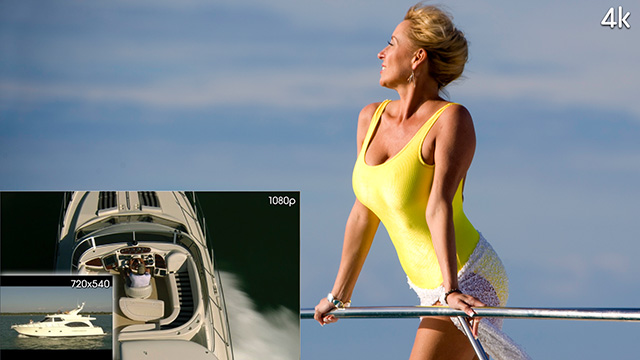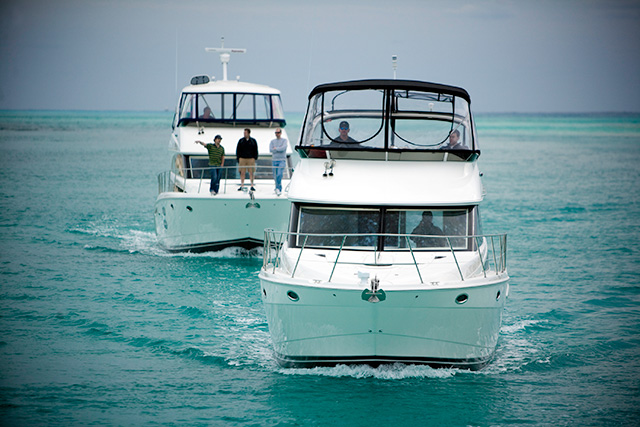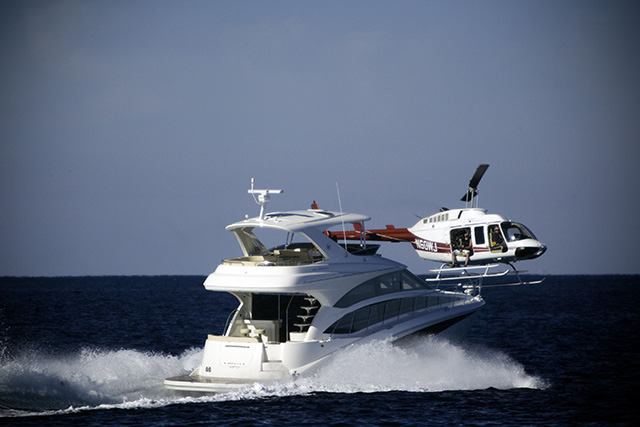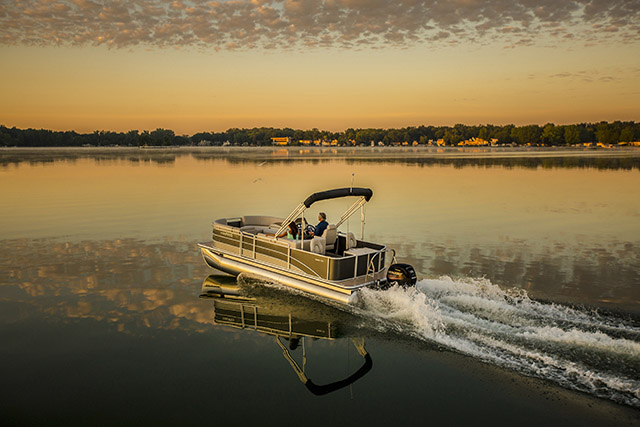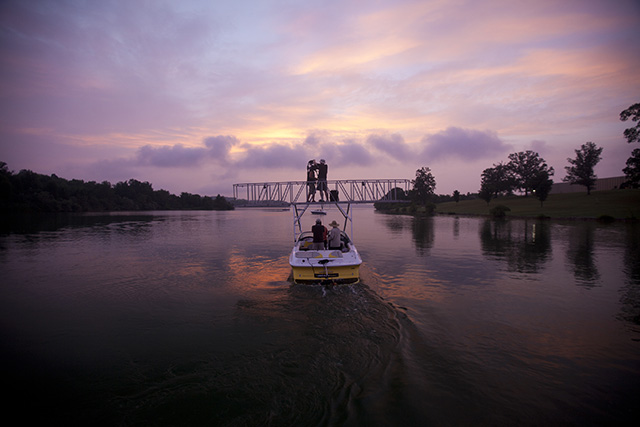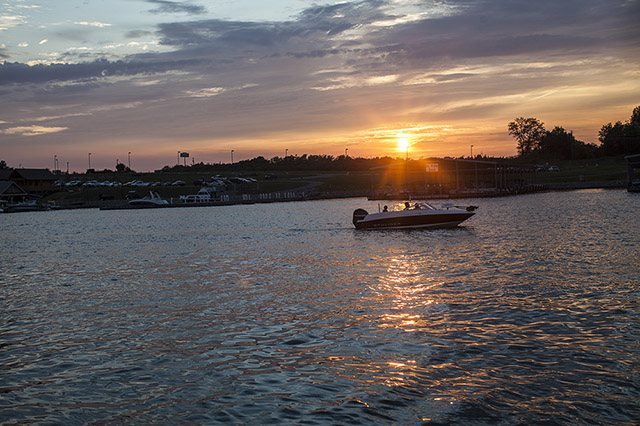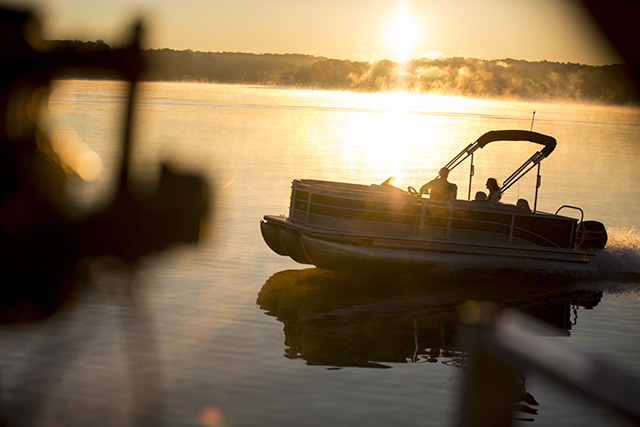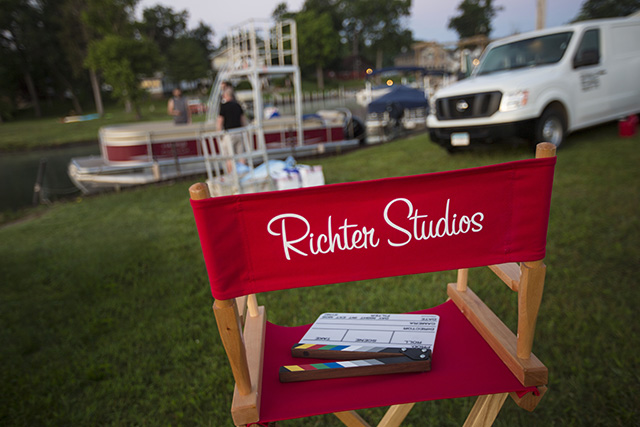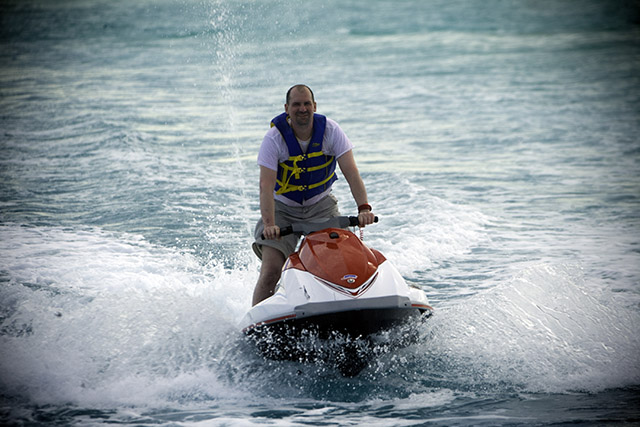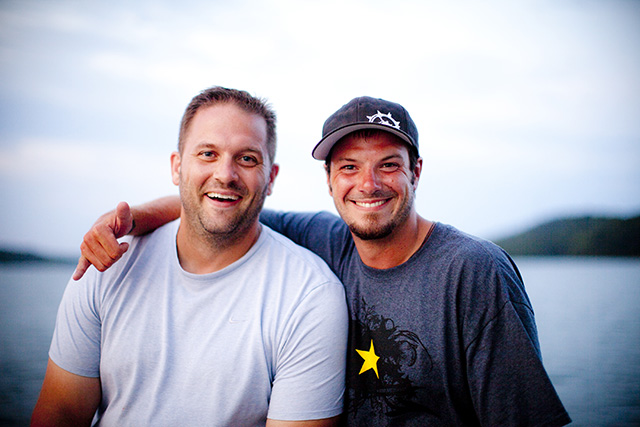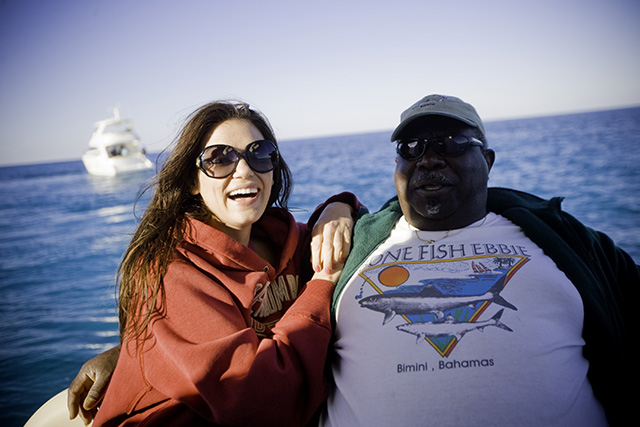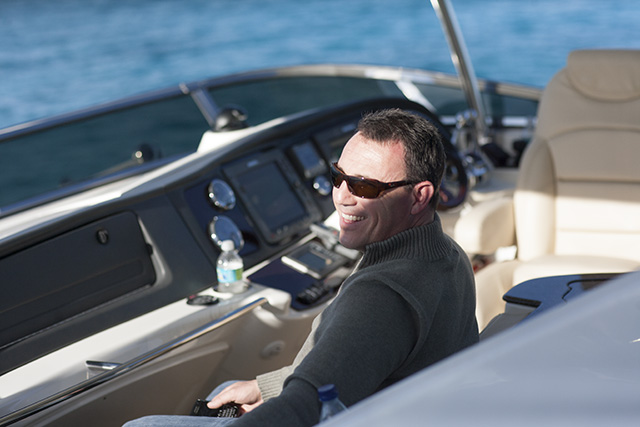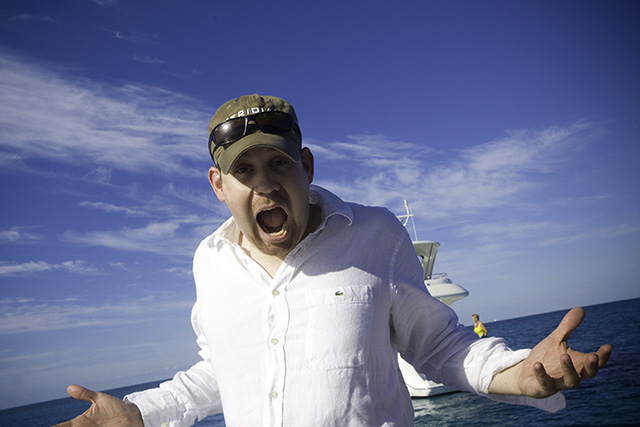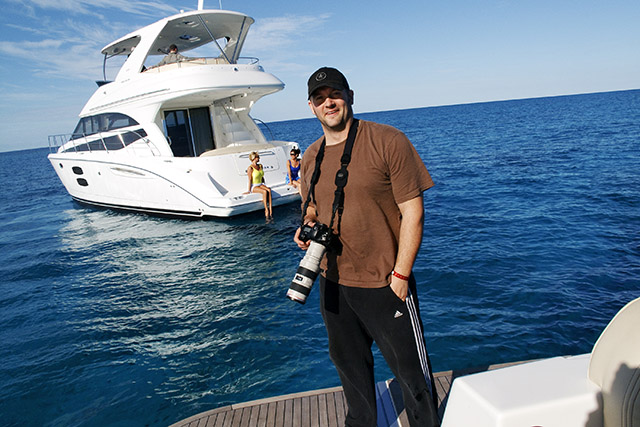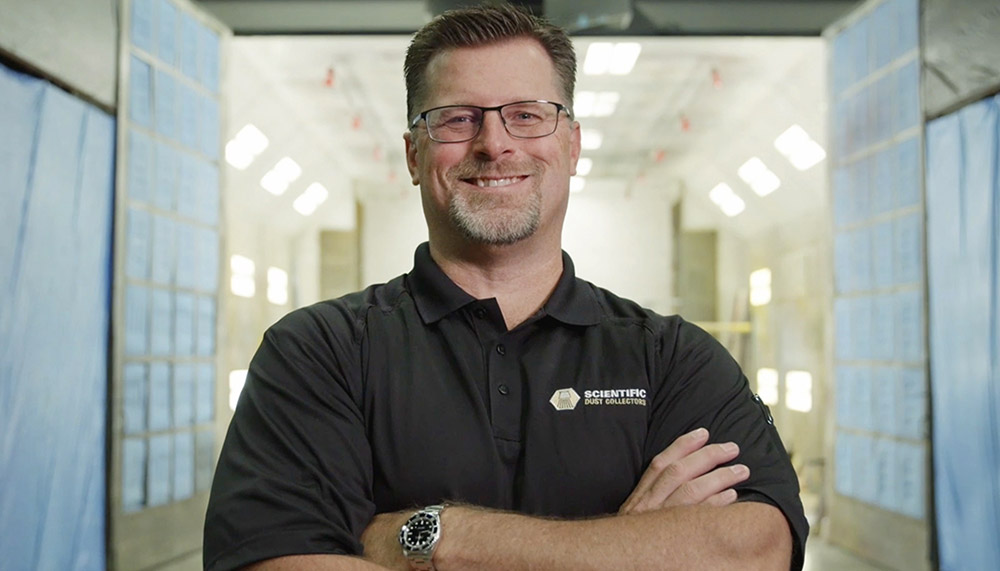A famous bookend to one of Bruce Lee’s philosophical observations was “Be water, my friend.” It is in the spirit of this quote that this article is being written. For years now, the team at Richter Studios has adapted many of its production techniques to develop a series of groundbreaking films for the boating industry. The results have been far-reaching, both for Richter Studios and the brands which have been involved.
I must first admit that I never thought I’d get the chance to say I nearly walked on water in this lifetime but, metaphorically speaking, I most certainly have….and then some. The crew at Richter Studios has earned the title of Chicago’s premier video production company by championing a range of lifestyle-related promo films and, among them, the ones we’ve produced for the boating industry have stood head and shoulders above the rest. How this came to be requires a deeper dive (pun intended) that goes back over seven years from the time I’m presently writing this. But before we dive into the way back time machine to tell this story, let’s take a look at our most recent effort for the boating industry, a 2016 brand film introducing the Harris model V270.
Harris Boats – V270 Model Launch
Interestingly enough, the road that led to films like the one above began because of a video that was stuttering on a website. The initial conversation about how to fix it ultimately led to a proven production philosophy which bears a strong resemblance to Lee’s full quote.
“Empty your mind, be formless. Shapeless, like water. If you put water into a cup, it becomes the cup. You put water into a bottle and it becomes the bottle. You put it in a teapot, it becomes the teapot. Now, water can flow or it can crash. Be water, my friend.” ~ Bruce Lee
His quote has a lot to do with keeping an open mind and flowing with the natural inertia of your surroundings. Don’t fight the current. Rather, embrace it. There is a great simplicity in what Lee is saying here but it is also very profound. In redefining how yachts, boats and pontoons have been marketed to the world through motion imagery, one of the core foundations we have embraced from day one has been to start with a blank canvas. We have also always been mindful of client realities or “currents” and to develop solutions which would lead to the path of greatest success.
At the time of our initial conversation about fixing the video playback issue (circa 2009), our research revealed that the boating industry’s best promotional materials were using very outdated production technologies which, frankly, had the visual quality of many forgettable “Miami Vice” episodes. So we first needed to start with a blank canvas and, thankfully in this instance, we had a very large one to work with. In large part, this canvas was made possible by a very ambitious, motivated (and fun!) individual who was a rising marketing star in the boating world, Matt Guilford. Our journey into the marine industry began with him.
Boating Industry Visionary, Matt Guilford

It was as random a day as any another when the phone rang one morning. The gentleman on the other end (Guilford) had been poking around our site and was impressed with the technology streaming our videos. This was late 2009 and Adobe Flash was still the standard for delivering video content, albeit just barely. “How can I get the videos on my site to play like the ones on yours? I don’t see any pauses or load times. No stuttering at all.” And that’s how it began. Guilford knew there had to be a better way and, at that time, Flash streaming was that better way.
Over the next few months, we talked about how to fix his video playback issues and even how some good ole’ Richter Studios color correction could enhance footage that was already shot. Guilford was intrigued at the possibilities. We understood his desire to make what he already had in-the-can even better, so once we resolved the video playback issue we turned our attention to improving the existing color. The video below shows a basic test we did with existing footage shot in 2008 and how color grading could improve the viewing experience.
Color Test (Existing Footage Not Shot By Richter Studios)
The more we discussed the road ahead with Guilford, the more we could sense his desire for perfection. When this became clear, the blank canvas concept took front and center stage. In order to follow the currents of thought moving forward and, as Wayne Gretzy famously observed, “skate to where the puck is going to be, not where it has been,” the team at Richter Studios knew the road ahead would require a bold new production approach. Since we had been filming in glorious 4K resolution (we now shoot up to 6K) with the original RED ONE for about two years at that time, our recommendation was to embrace a very cinematic approach. The previous footage (seen above) had been mastered at just 720 x 540 resolution with a limited image sensor. What we recommended was filming in 4K (4096 x 2160 resolution with a 4:2:2 color space). This would be a dramatic uptick in the amount of image detail and dynamic range. We shared the graphic below to illustrate where things were (720 x 540) and the place they needed to be (4K) to maximize the visual potential for future promotional films.
After sharing the above graphic, as well as several examples of other productions we had shot in 4K, we agreed on the format. 4K was the decision. However, because this production would require footage shot not only from the land, but boat-to-boat and from the air as well, we still had more convincing to do before Guilford was sold on an entirely new approach and film crew. Thankfully, we had been filming and photographing from both helicopters and from several skyscrapers since 2007. We had also captured (in 2008) some absolutely amazing skyscraper footage, including this gem of the Trump Tower in Chicago where we climbed the tower crane atop the 98-story building during the final months of construction.
Aerial of Trump International Hotel & Tower
During the summer of 2007, we had spent significant time filming helicopter aerials for the The Walsh Group. We learned a great deal about differing types of gyroscopic camera mounts and what the limitations and advantages were for each. We created over a dozen videos that year for Walsh, many of which featured helicopter aerials. Below is a video of our first take-off in a helicopter with our camera mount at Chicago Midway International Airport.
Helicopter Mount Test (August 2007)
Filming the Chicago skyline that summer was an incredible experience and we captured stunning aerials of many signature Walsh projects. The following behind-the-scenes photo was taken in Grant Park and, near the center-right of frame, is the original HCSC building which was designed by Goettsch Partners and constructed by Walsh.
Executive Producer, Ed Grozich, Reviews Footage During Aerial Shoot

Shortly after this photo was taken, Walsh was awarded the HCSC Vertical Completion Project which called for the addition of 24 stories atop the existing 33 story structure. Richter Studios was honored to have been tasked with documenting this one-of-a-kind construction project and the film we produced features aerials taken from both helicopters and nearby skyscraper rooftops.
The Walsh Group – HCSC Building
After reviewing our aerial experience, Guilford’s last remaining reservation was in how we would compensate for ocean swells when filming from one vessel to capture another. After some research, we identified a possible solution in a stabilization platform known as the Perfect Horizon. To prove our theory, Guilford helped us secure a vessel on Lake Michigan which we used to produced a short video documenting our findings.
Gyro-Stabilization Test by Richter Studios on Lake Michigan
After seeing this video, the rest – as they say – was history. Well, to be fair, we still had to pack our our bags and do quite a bit of gear prep before we left Chicago. More so than for any other shoot, we really had to dot our “I’s” and cross our “T’s” because we were headed to the Bahamas. And in a location as remote as this one, the kind of radically advanced camera technology we would be relying on couldn’t be found for many hours in any direction. Everything had to work as anticipated, so we ran gear checks in triplicate. We even recorded this fun time-lapse while we went through the paces.
Meridian Yachts – Gear Prep (circa 2010 at Previous Studio)
Barely two months later, we boarded a plane to Miami to film the first of many groundbreaking films for the marine industry. The first production with Guilford was for Meridian Yachts, a relatively new brand in the luxury yacht market. Our film crew consisted of just four talented and fearless individuals. But, when you added the Meridian crew which included ship captains, boat wranglers and talent, the total number of bodies was closer to 20. From South Beach, we boarded the yachts and headed to the island of Bimini in the Bahamas. It was there that we planned to capture five brand films that we all hoped would be game changers. The pictures below show the crew before we left Miami and then arriving in Bimini.
Our goal was to spend as much time as possible filming out in the open ocean, so returning to shore to transfer film gear from one yacht to another was out of the question. Instead, we improvised – pulling yachts alongside one another and handing gear across and using jet skis to move equipment and crew between vessels and remote islands.
Once the cameras started rolling, we had just 48 hours to capture pure magic. It was a tall order but, in looking at the side-by-side comparison of our footage next to the previously shot footage, pure magic is exactly what we captured.
In addition to the visual comparisons above, the other major takeaway during the shoot was just how fantastic the aerials turned out. If you can believe it, we had less than ten – YES TEN – total minutes of flight time per yacht. We planned meticulously but the margin for error was near zero. We had to maximize every second we were in the air. Thankfully the pilot, captains, talent and film crew were up to the challenge even though, as these behind-the-scenes photos show, we choreographed some challenging aerial maneuvers.
When it was all said and done, we felt confident that we had captured the footage we were after. Everyone felt a sense of relief that the mission was accomplished and, as can be seen in these behind-the-scenes videos, there was cause for celebration. The first video is from the perspective of the boat viewing the helicopter in its final pass by the production crew; and the second video is that same shot from the perspective of the helicopter.
Bahamas Helicopter BTS (2010 Shoot, from boat)
Bahamas Helicopter BTS (2010 Shoot, filming crew on boat)
Although our celebration seemed appropriate at the time, the real proof would come when we began piecing together our footage. It didn’t take long to put together a sneak preview for Guilford to review and his reaction was priceless:
“I remember VIVIDLY when I first received a demo clip shortly after our shoot. It was a feeling of euphoria; elation. All the work, the risk, the chaos and problems we had to overcome on site, the decision that we should pioneer this with Richter Studios — all of it was confirmed in the first 15 seconds I got back. There aren’t many instances like that in a career — where you’ve risked so much and you set a new bar for an industry. I’ve got a handful of those, and that moment will stay with me for the rest of my career.” ~ Matt Guilford
Despite having only 48 hours to capture our footage, the team at Richter Studios produced five separate brand films that proved to be game-changers for the boating industry. Not only were we able to incorporate some unique animation treatments to highlight various features of the yachts, we also sought to use color treatments as a differentiator. With the RED Raw format, we had a significant creative flexibility during the color grading process. This enabled us to create unique looks for each film even though the footage was captured, in many instances, just minutes apart. A good illustration of this creative latitude can be seen by comparing the final 341 and 391 films:
Meridian Yachts – 341 Sedan
Meridian Yachts – 391 Sedan
It didn’t take long for word to get out about these films and the reaction was truly inspiring. What began as a first-time collaboration – with modest expectations and a fair amount of risk – quickly blossomed into something far more meaningful for the Meridian Yachts brand. Following the debut of the films at the Miami Boat Show, Guilford summarized viewer reaction in this way:
“I’ve had the largest boat dealership in the world tell me they’re the best boat films they’ve ever seen. I have had countless dealers tell me they’ve never seen anything like it in 10-20-30 years.” ~ Matt Guilford
Thankfully, the fun didn’t end here. Guilford was promoted to Director of Marketing and Brand Manager of Meridian Yachts and Bayliner Boats. The Bayliner brand opened the door to a much wider audience and, although the stakes had been raised significantly, the results were largely the same. Interestingly, we didn’t use jet skis to shuttle the equipment around like we had in the Bahamas. Instead, we did it the old fashioned way . . .
The Bayliner shoot came with its own set of challenges – chief among them the grueling weather conditions. Being honest, “grueling” is putting it mildly – the temperature hovered around 100 degrees fahrenheit. This proved to be a serious challenge for both crew and equipment. So much so that one unlucky crew member had to sleep with the air conditioning off to keep his hotel bunk mates – our lenses – from fogging up in the oppressive heat and humidity the following morning.
Another challenge to overcome for the Bayliner shoot was how to film rock-steady handheld footage from the “wings” of a photo boat. This is something we hadn’t attempted during the Meridian shoot – frankly because the subject yachts were too large and because the ocean swells would have devoured us in a matter of seconds. But on Tellico Lake near Knoxville, Tennessee, this was an ideal solution to get up close and personal with the subject boats and capture the shots we were after. As can be seen in these behind-the-scenes photos, the trick with this type of photo boat is getting the balance just right. Our cinematographer’s movements on one wing would need to be compensated for by equal movements by another crew member on the opposite wing.
Lasting a full week, from well before dawn to well after dusk, the Bayliner shoot was certainly exhausting – but it was filled with many great and memorable experiences as well. Including cast and crew, around two dozen passionate souls chased perfection that week and each of us who were there will never forget it. As is evident in this never-before-seen BTS film, the smiles and camaraderie were everywhere:
Bayliner – Behind The Scenes Film (August 2011)
All told, we produced well over a dozen films for Bayliner and we’re proud of each and every one of them. If we had to pick a favorite however, I think everyone would agree that there’s something very special about this 60 second commercial that really captures the essence of boating and the Bayliner brand:
Bayliner – “So Worth It” :60 Second Spot
Shortly after the Bayliner films were made public, we got a call from Harris Boats to inquire about our services. We were surprised to learn that, although Harris is a sister company to both Meridian Yachts and Bayliner, they had found us independently – not through a referral of any kind. Needless to say, it didn’t take long for Harris to recognize our synergies and we soon found ourselves out on the water again with another boating company.
We’re now entering our 5th year as the creative partner behind the Harris Boats and, more recently, Cypress Cay brand films. As with Meridian and Bayliner before, Richter Studios has continued to innovate – embracing new technologies and new cinematic techniques. The stunning aerials that we once captured from helicopters are now captured from more versatile UAS – or drone – platforms. The impact of drone aerials is simply radical – in terms of the cost savings we can pass on to our clients over traditional helicopter aerials – but, more importantly, in terms of quality, efficiency and perspectives we’re able to capture that were never before possible. The following photos provide a behind-the-scenes glimpse of our first drone shoot for the boating industry.
In addition to filming with drones, we’ve also re-thought our approach to motion stabilization, given new technologies like the DJI Ronin. Though less suitable for the ocean swells we encountered at Bimini, this light-weight gyro-stabilization system offers greater versatility on calmer waters. By using this custom setup, cameras are operated remotely with greater control and less weight on the tower which translates into more maneuverable photo boat. The following photos show cinematographer, Joe Martinez, Jr., seated near the stern while controlling a RED Epic that’s mounted to a Ronin high atop the photo boat.
The results of aerial and stabilization innovations proved spectacular. Richter Studios developed four 2016 model year films for the Harris and Cypress Cay brands and our client is as thrilled with the results as we are:
“The team at Richter Studios consistently delivers high-end commercial cinematography showcasing our two brands of boats. Even though our shoots follow relatively the same process each year, Richter Studios always seems to have the latest and greatest equipment and fresh ideas that really help make our products stand out from the competition.” ~ Mark Wyrick, Brunswick Leisure Boat Co. (Harris Boats / Cypress Cay Pontoons)
The results of our longstanding collaboration with Cypress Cay and Harris can be seen in these recent films.
Cypress Cay – 2016 Brand Film
Harris Boats – 2016 Brand Film
Harris Boats – Twin Engine Platform
As a footnote to this article – while we continue to work with the Harris and Cypress Cay brands, we haven’t worked for either Meridian Yachts or Bayliner for several years. In fact, Guilford himself is no longer with the Brunswick Boat Group. From our perspective, it doesn’t matter. Whatever challenges may lie ahead for either of us, we know they will be met with the same zeal and determination we shared many years ago – to dream the impossible and to have the courage to reach for it. Our paths may have diverged but I’m confident that the greatest journeys are still ahead – for both of us. Richter Studios is always seeking the next great challenge and – as we do on every creative endeavor – we’re eager to prove that open, creative minds and an ability to continuously adapt are all that is needed to succeed. We’re not alone in this thinking – I know this same approach and philosophy will be at the core of Guilford’s next great adventure. And when that journey begins, to him we say with a smile “Be Water, My Friend.”
Below are pictures of our incredible seven year journey. If you’d like to learn more about how we can help you elevate your brand, contact us for an informative consultation.


